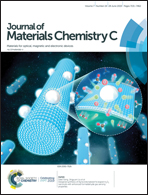Coercivity enhancement and mechanism in a high Ce-containing Nd–Ce–Fe–B film by the design of a diffusion layer
Abstract
Herein, the Nd–Ce–Fe–B film was used as a model system to evaluate the full potential of Ce magnets with high Ce concentration and characterize the high-coercivity mechanism of magnets. A significant coercivity enhancement and the high-coercivity of 24.8 kOe (much higher than previously reported values) were achieved in very high Ce-substituted (67.3 at%) film magnets by the design of Ce/Cu diffusion layers via a new multifaceted approach. The mechanism of enhanced coercivity was comprehensively analyzed based on the microstructure and domain-structure observations as well as micro-magnetic theory. The magnetically well-separated grains with fine size and unexpected superior microstructure are responsible for the extremely high coercivity in these high Ce-containing film magnets. The microstructure parameters α and Neff in the present high-coercivity Ce film magnet are superior than those in the Nd–Fe–B magnets due to the specific character of Ce-metal boundary phases. Our study indicates that although the intrinsic anisotropy HA decreases distinctly in high Ce-substituted magnets, a high coercivity can still be obtained due to the accessible superior microstructure as compared to the case of the Nd–Fe–B magnets. Our study opens up the door for more effective utilization of highly abundant and cheap Ce resource. It is also significant for diffusion layer designs in high-performance diffusion-processed magnets.



 Please wait while we load your content...
Please wait while we load your content...